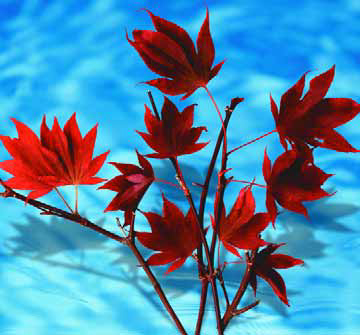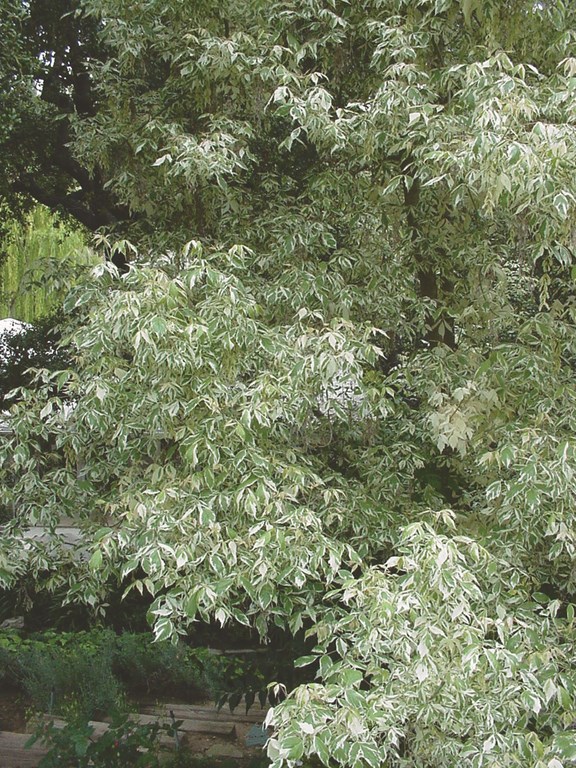Maples in the Garden

If I could point to one plant that will consistently stand out in just about any garden, it would have to be the maple. Virtually no Asian-style garden would be complete without one, and they fit beautifully into gardens of many other styles as well.
I particularly like pairing maples with watershapes because of their tendency to soften the edges of typical hardscapes and the way they are reflected by the water. When placed well, a specimen or single maple can indeed be a key focal point in any design.
There are so many species and varieties of maples that I couldn’t possibly cover them all here. What I can and will focus on, however, are those that work particularly well as specimens that can set themselves apart in any garden.
ALL ABOUT MAPLES
In broad terms, maples – known as Acer in the plant kingdom – are deciduous trees and shrubs that can, depending upon variety, be placed in anything from full sun to partial shade.
Even though it’s usually a good idea to minimize the use of deciduous plants around watershapes, I’ve found that maples are a great exception to the rule. True, they can add considerably to the maintenance burden during the fall, but the graceful, statuesque form they offer through the rest of the year is a stunning complement or accent to almost any watershape.
Maples (particularly the larger varieties) are notorious for invasive root systems that make many of them questionable around watershapes. But the root systems of the particular varieties I’ll be mentioning below are typically noninvasive, making them wonderful natural companions to watershapes. As always, check with your local nursery or a good garden guide for the characteristics of the specific variety you intend to plant.
Availability is also an issue with maples. Typically, your local nurseries carry only specimens and varieties that are established performers in your area. If you’re looking for a variety that isn’t carried, there’s probably a reason – that is, the particular variety you’re after may not thrive in your area and nurseries are unlikely to carry plants with which clients will not be successful.
By the same token, it may simply be that your local suppliers have never heard of or tried the variety you’re after and recognize little demand for it. As I’ve suggested before in this column, be a trailblazer: It’s worth asking and, in some cases, pushing your nurseries to try new plants!
And those choices are many. Maples come in all shapes and sizes and in a variety of colors – and tend to be among the most striking of all fall-foliage plants, particularly in colder climates. The leaf colors range from light-yellow and dark greens to bronzes and burgundies, and many are variegated, some white with green and others burgundy and green along with many other combinations. The choices are extensive, and there are also varieties that feature colorful bark that can become a real highlight in a winter landscape.
FAVORITE MAPLES
One last point before I get to my favorite maples: The smaller varieties are particularly popular in Asian gardens, where their pruning approaches an art form. To be blunt, my experience is that most “tree trimmers” don’t understand maples well enough to maintain the artistic, planar form that can set maples apart.
If you plan on installing a maple in a client’s garden and having it maintained in a way that expresses its artistic potential for the long haul, it’s a good idea to find a pruning specialist who is skilled in this arena. It can make all the difference between a spectacular plant and one you want to rip out because it looks so bad. It can also make quite a difference in your business and reputation as your clients come to see that you care about more than just the bottom line.
Here are a few of my favorite maples – those I’ve planted for clients and those I’ve planted in my own garden as well. Most of these trees will tend to be more expensive than other varieties, but they are well worth the investment.
[ ] Acer palmatum (Japanese Maple). This is an extremely large category of plants and offers varieties in a wide range of sizes and colors. Most could reach a mature size of 20 feet, but they are usually pruned to stay under ten feet because smaller specimens create more visual interest, especially when well shaped and cared for.
These trees are ideal for small gardens and those with lots of partial shade. They are also good container plants, although they’ll always do better when planted in the ground. The genus and species name (Acer palmatum) denotes the green leaf variety. Others in this family are further identified with varietal names:
* ‘Atropurpureum’ (Red Japanese Maple). This variety is a great addition to a space where you need contrasting colors. I’ve planted them singly against a wall surrounded by only groundcovers (these are particularly striking when placed against great paint colors that really show them off), or among other foliage colors in a more lush landscape.
These trees are a good substitute for Purple Leaf Plums in spots that may be too shady for the plums. Surrounding them with light-green foliage or even grey foliage creates dramatic effects – but if you want something subtler, surround them with medium to dark-green plants. Just make sure these plants have vertical room to grow, as they can reach heights of 20 to 30 feet if allowed to do so.
* ‘Bloodgood.’ This is a particularly good variety and is visually similar to ‘Atropurpureum.’ It will want to grow to about 15 feet tall, but it can be kept smaller with pruning.
* ‘Dissectum’ (Threadleaf Maple). This fine-toothed, green-leaf maple is a staple in most Japanese gardens. It’s a small tree, typically reaching just five- or six-foot height at maturity. It’s also quite graceful, its branches having a gentle weeping form and a very soft appearance.
I like placing these at the edge of watershapes, particularly small ponds and natural streams. I also see these as ideal for placement near or in contemporary reflecting pools or ponds that catch reflections of tree and sky. In fact, this is a case where each specimen should have its own visual space, meaning I would not overuse them in a garden and would place each one so that it is viewed apart from others.
Please remember, however, that there are no hard and fast rules for landscaping. Although I haven’t found the right situation yet, there may be a design that calls for massing maples.
* ‘Dissectum Atropurpureum’ (Red Threadleaf Maple). This is the burgundy-leafed variety of the threadleaf maple, and I’ve also successfully used a variety called ‘Dissectum Red Dragon’ – both types making great individual specimens.
Even more than with the green-leaf ‘Dissectum,’ these maples should be used sparingly, as their color and unique nature can be overdone if too many specimens are placed in one setting. I’ve tended to use them in designs that call for plants that will stay relatively small or that are being set up in shadier locations that need a focal point or some contrast to green plants.
* ‘Sango Kaku’ (Coral Bark Maple). I discovered this variety purely by accident while roaming through a selection of ‘Dissectum’ one day. One of these plants had been placed inadvertently with the other maples, but I was intrigued by its unusual bark color and immediately researched its characteristics. (I always love uncovering something I haven’t seen anywhere else.)
What I learned is that this is an upright grower with green leaves and that it is at its best in cold climate. Since then, I’ve planted these trees at projects near the beach in Santa Monica up in the mountains at Lake Arrowhead, where it becomes a winter focal point. The coral-colored bark is especially striking against the snow at Lake Arrowhead, but it stands out year ’round in settings where most everything else has dull, brown bark.
[ ] Acer negundo ‘Variegatum’ (Variegated Box Elder). When I was taking plant-identification classes some 15 years ago, the school I attended had a long walkway planted on either side with these trees. This was during the winter months, and the trees looked dead.
| One of the joys of my own backyard is this variegated box elder – one of three I planted many years ago. I value them particularly for the way they brighten up shady areas of any garden. |
As soon as they leafed out, however, it was clear to me that this would become one of my all-time favorites: The leaves were mostly white, with a small dash of green in the center of the leaves, and no matter where I looked in the surrounding landscape, my eye always came back to these spectacular trees.
Five years later, I found three 15-gallon specimens in a nursery and quickly scooped them up. They are still the most stunning plants in my garden (seen at left) and surprise me each year with new characteristics. What I didn’t know when I first viewed them at school was that they grow “weeping pods” that give the tree a weeping appearance, even though the branching structure is upright.
These trees can get to be 20 to 30 feet tall, but they can easily be pruned to stay under 15 feet. They’re well suited to shade and are very effectively used under the canopy of larger trees – the benefit being that they brighten up shadier areas of any garden.
The biggest problem with these plants is that they are now extremely difficult to get. I know of only two growers in the United States that propagate them, and in order to get one today, I’d have to order 200 at once. I can only wish I had that kind of space!
* ‘Flamingo.’ This variety of variegated box elder is more commonly available than ‘Variegatum’ and is similar in nature – but with a dash of coral pink on its leaves. To my eye, the coral pink detracts somewhat from the striking appearance of the white leaves, but it’s a reasonable alternative if you can’t find the real thing.
I encourage you to try these varieties or inquire with your local nursery about other varieties they might carry. There are very few designs in which maples would not be welcome in one form or another. And if you have a favorite you particularly like, please let me know: I’m always on the lookout for something new!
Stephanie Rose wrote her Natural Companions column for WaterShapes for eight years and also served as editor of LandShapes magazine. She may be reached at [email protected].











